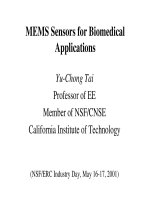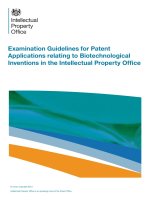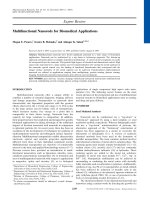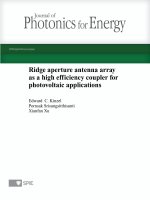mems for biomedical applications
Bạn đang xem bản rút gọn của tài liệu. Xem và tải ngay bản đầy đủ của tài liệu tại đây (25.56 MB, 491 trang )
© Woodhead Publishing Limited, 2012
MEMS for biomedical applications
© Woodhead Publishing Limited, 2012
Related titles:
Implantable sensor systems for medical applications
(ISBN 978-1-84569-987-1)
Intelligent sensor systems for medical applications can greatly improve quality of
life and medical care. This book discusses the core technologies needed for these
sophisticated devices and their current and potential applications. Chapters in Part
I review a wide range of core technologies that are fundamental to intelligent medi-
cal sensor systems. Part II reviews considerations for intelligent medical sensor sys-
tems and the fi nal part discusses the various applications areas of intelligent sensor
systems.
Biomedical imaging: Applications and advances
(ISBN 978-0-85709-127-7)
The development of imaging techniques is of great importance for the monitoring of
medical implants, diagnosis of disease, and for strategies of personalized medicine.
Signifi cant advances are being made in this technology and this book discusses the
latest advances and developments in this increasingly important fi eld. Chapters in
Part I provide readers with a wide ranging review of medical applications whilst the
second set of chapters discusses biomaterials and processes.
Biosensors for medical applications
(ISBN 978-1-84569-935-2)
Biomedical sensors play an important role in the detection and monitoring of a range
of critical medical conditions. This publication provides readers with a comprehen-
sive review of established, cutting edge, and future trends in biomedical sensors and
their applications. Chapters in Part I discuss principles and transduction approaches
to biosensors. Part II reviews a wide range of applications.
Details of these and other Woodhead Publishing books can be obtained by:
• visiting our web site at www.woodheadpublishing.com,
• contacting Customer Services (e-mail: ; fax:
+44 (0) 1223 832819; tel.: +44 (0) 1223 499140 ext. 130; address: Woodhead
Publishing Limited, 80 High Street, Sawston, Cambridge CB22 3HJ, UK),
• contacting our US offi ce (e-mail: ; tel.
(215) 928 9112; address: Woodhead Publishing, 1518 Walnut Street, Suite 1100,
Philadelphia, PA 19102-3406, USA).
If you would like e-versions of our content, please visit our online platform:
www.woodheadpublishingonline.com. Please recommend it to your librarian so that
everyone in your institution can benefi t from the wealth of content on the site.
© Woodhead Publishing Limited, 2012
Woodhead Publishing Series in Biomaterials: Number 43
MEMS for biomedical
applications
Edited by
Shekhar Bhansali and Abhay Vasudev
Oxford Cambridge Philadelphia New Delhi
© Woodhead Publishing Limited, 2012
Published by Woodhead Publishing Limited,
80 High Street, Sawston, Cambridge CB22 3HJ, UK
www.woodheadpublishing.com
www.woodheadpublishingonline.com
Woodhead Publishing, 1518 Walnut Street, Suite 1100, Philadelphia,
PA 19102-3406, USA
Woodhead Publishing India Private Limited, G-2, Vardaan House, 7/28 Ansari Road,
Daryaganj, New Delhi – 110002, India
www.woodheadpublishingindia.com
First published 2012, Woodhead Publishing Limited
© Woodhead Publishing Limited, 2012
The authors have asserted their moral rights.
This book contains information obtained from authentic and highly regarded
sources. Reprinted material is quoted with permission, and sources are indicated.
Reasonable efforts have been made to publish reliable data and information, but
the authors and the publishers cannot assume responsibility for the validity of all
materials. Neither the authors nor the publishers, nor anyone else associated with
this publication, shall be liable for any loss, damage or liability directly or indirectly
caused or alleged to be caused by this book.
Neither this book nor any part may be reproduced or transmitted in any form or
by any means, electronic or mechanical, including photocopying, microfi lming and
recording, or by any information storage or retrieval system, without permission in
writing from Woodhead Publishing Limited.
The consent of Woodhead Publishing Limited does not extend to copying for
general distribution, for promotion, for creating new works, or for resale. Specifi c
permission must be obtained in writing from Woodhead Publishing Limited for
such copying.
Trademark notice: Product or corporate names may be trademarks or registered
trademarks, and are used only for identifi cation and explanation, without intent to
infringe.
British Library Cataloguing in Publication Data
A catalogue record for this book is available from the British Library.
Library of Congress Control Number: 2012938840
ISBN 978-0-85709-129-1 (print)
ISBN 978-0-85709-627-2 (online)
ISSN 2049-9485 Woodhead Publishing Series in Biomaterials (print)
ISSN 2049-9493 Woodhead Publishing Series in Biomaterials (online)
The publisher’s policy is to use permanent paper from mills that operate a
sustainable forestry policy, and which has been manufactured from pulp that is
processed using acid-free and elemental chlorine-free practices. Furthermore, the
publisher ensures that the text paper and cover board used have met acceptable
environmental accreditation standards.
Typeset by Newgen Publishing and Data Services
Printed by TJ International Ltd, Padstow, Cornwall, UK
v
© Woodhead Publishing Limited, 2012
Contents
Contributor contact details xi
Woodhead Publishing Series in Biomaterials xv
Introduction xix
Part I Fundamentals of MEMS for biomedical applications 1
1 Microfabrication of polymers for bioMEMS 3
P. R EZAI, W-I. WU and P. R. SELVAGANAPATHY,
McMaster University, Canada
1.1 Introduction 3
1.2 Microfabrication 4
1.3 Polymers and processes 8
1.4 Conclusions 34
1.5 References and bibliography 35
2 Review of sensor and actuator mechanisms
for bioMEMS 46
P. K. S
EKHAR and V. UWIZEYE, Washington State
University Vancouver, USA
2.1 Introduction: transducers 46
2.2 Sensors 47
2.3 Actuators 55
2.4 Biomedical applications of sensors and actuators 62
2.5 Optical biosensor 65
2.6 Microrobotics in biomedical applications 71
2.7 Conclusion 75
2.8 References 76
© Woodhead Publishing Limited, 2012
vi Contents
Part II MEMS for biomedical sensing and
diagnostic applications 79
3 MEMS for in vivo sensing 81
S . A
RAVAMUDHAN, North Carolina
A&T State University, USA
3.1 Introduction 81
3.2 Overview of MEMS in vivo devices and sensors 83
3.3 Challenges and possible solutions to in vivo
sensing methodology 89
3.4 Regulatory dimensions 92
3.5 Conclusions and future trends 93
3.6 References 93
4 MEMS and electrical impedance spectroscopy (EIS)
for non-invasive measurement of cells 97
D . T. P RICE, University of South Florida, USA
4.1 Importance of MEMS in cellular assays 97
4.2 Impedimetric measurement theory 98
4.3 Visualization and modeling 100
4.4 Bioimpedance before MEMS: patch clamp measurements 102
4.5 MEMS in bioimpedance applications 104
4.6 Future trends 116
4.7 Sources of further information and advice 116
4.8 References 117
5 MEMS ultrasonic transducers for
biomedical applications 120
R. G
ULDIKEN and O. ONEN, University of South
Florida, USA
5.1 Introduction 120
5.2 Modeling and design of capacitive micromachined
ultrasonic transducers (CMUTs) 123
5.3 Fabrication 128
5.4 Integration 133
5.5 Biomedical applications 134
5.6 Conclusion and future trends 142
5.7 References 144
© Woodhead Publishing Limited, 2012
Contents vii
6 Lab-on-chip (LOC) devices and microfl uidics for
biomedical applications 150
K. W. O
H, University at Buffalo, The State University
of New York (SUNY), USA
6.1 Introduction 150
6.2 Pressure-driven lab-on-chip (LOC) 151
6.3 Capillary-driven LOC 154
6.4 Electrokinetic-driven LOC 157
6.5 Centrifugal-driven LOC 159
6.6 Droplet-based LOC 162
6.7 Electrowetting-based LOC 164
6.8 Future trends 166
6.9 Sources of further information and advice 167
6.10 References 168
Part III MEMS for tissue engineering and clinical applications 173
7 Fabrication of cell culture microdevices for tissue
engineering applications 175
J. D. C
UIFFI, Draper Laboratory, USA
7.1 Introduction: cell culture microdevices 175
7.2 Motivation for microdevice development 175
7.3 Design and fabrication concepts for cell culture 179
7.4 Applications of cell culture microdevices 185
7.5 Future trends 188
7.6 Sources of further information and advice 188
7.7 References 189
8 MEMS manufacturing techniques for tissue
scaffolding devices 192
C-W. LI and G-J. WANG, National Chung-Hsing
University, Taiwan
8.1 Introduction 192
8.2 Tissue scaffold design 193
8.3 Tissue scaffold fabrication using MEMS approaches 198
8.4 Applications of MEMS-fabricated tissue scaffold 210
8.5 Conclusion 213
8.6 References 213
© Woodhead Publishing Limited, 2012
viii Contents
9 BioMEMS for drug delivery applications 218
L. K
ULINSKY and M. J. MADOU, University of California,
Irvine, USA
9.1 Introduction 218
9.2 Transdermal delivery 219
9.3 Implantable systems 236
9.4 Microfabricated drug delivery vehicles 246
9.5 Conclusions 249
9.6 Acknowledgement 250
9.7 References 250
10 Applications of MEMS technologies for
minimally invasive medical procedures 269
K. R. OLDHAM, University of Michigan, USA
10.1 Introduction 269
10.2 Microvisualization 270
10.3 Micromanipulation 280
10.4 Future trends and conclusions 286
10.5 References 287
11 Smart microgrippers for bioMEMS applications 291
Y. Q. F
U, University of the West of Scotland, UK,
J. K. LUO, University of Bolton, UK and A. J. FLEWITT
and W. I. M
ILNE, University of Cambridge, UK
11.1 Introduction 291
11.2 Microgripping and release strategies 293
11.3 Microgripper demonstration: microcage 306
11.4 Conclusions 327
11.5 Acknowledgement 330
11.6 References and bibliography 330
12 Microfl uidic techniques for the detection,
manipulation and isolation of rare cells 337
M. B. SANO and R. V. DAVALOS, Virginia Tech – Wake
Forest School of Biomedical Engineering, USA
12.1 Introduction 337
12.2 Sized-based isolation 338
12.3 Mass-based isolation 343
12.4 Electrical-based isolation 346
12.5 References 355
© Woodhead Publishing Limited, 2012
Contents ix
Part IV Emerging biomedical applications of MEMS 359
13 MEMS as implantable neuroprobes 361
A. V. G
OVINDARAJAN and M. JE, Institute of Microelectronics,
Singapore, W-T. PARK, Seoul National University of Science
and Technology, Korea and A. K. H. ACHYUTA, The Charles
Stark Draper Laboratory Inc., USA
13.1 Introduction – neuronal communication 361
13.2 MEMS-based neuronal intervention devices 363
13.3 Tissue response against implanted neural microelectrode
interfaces 382
13.4 Implantable wireless recording integrated circuit (IC)
challenges 387
13.5 References 388
14 MEMS as ocular implants 396
W. L I, Michigan State University, USA
14.1 Introduction 396
14.2 Implantable MEMS for glaucoma therapy 397
14.3 Integrated microsystems for artifi cial retinal implants 408
14.4 Future trends 418
14.5 Conclusion 420
14.6 References 421
15 Cellular microinjection for therapeutics and
research applications 432
P. K
HANNA, Globalfoundries, USA
15.1 Introduction 432
15.2 Signifi cance of cellular injection 433
15.3 Microinjection 435
15.4 MEMS technologies for microinjection 437
15.5 Future of mechanical microinjection 441
15.6 Automating microinjection 442
15.7 Conclusion 444
15.8 References 444
16 Hybrid MEMS: Integrating inorganic structures
into live organisms 449
A. J. SHUM and B.A. PARVIZ, University of Washington, USA
16.1 Introduction 449
© Woodhead Publishing Limited, 2012
x Contents
16.2 Hybrid integration 450
16.3 Vacuum microfabrication on Drosophila 4 5 9
16.4 Conclusions and future trends 471
16.5 References 473
Index 475
xi
© Woodhead Publishing Limited, 2012
(* = main contact)
Editors
Shekhar Bhansali*
Department of Electrical and
Computer Engineering
Florida International University
USA
E-mail: Shekhar.bhansali@fi u.edu
Abhay Vasudev
Department of Biomedical
Engineering
Florida International University
USA
E-mail: avasu002@fi u.edu
Chapter 1
Pouya Rezai, Wen I. Wu and P. Ravi
Selvaganapathy*
JHE 316, Department of
Mechanical Engineering
McMaster University
1280 Main St W, Hamilton
Ontario
L8S 4L7
Canada
E-mail:
Chapter 2
Praveen Kumar Sekhar*
Assistant Professor, Electrical
Engineering
School of Engineering and
Computer Science
Washington State University
Vancouver
VECS 201W
14204 NE Salmon Creek Avenue
Vancouver, WA 98686-9600
USA
E-mail: praveen.sekhar@vancouver.
wsu.edu
Vianney Uwizeye
Undergraduate Student
School of Engineering and
Computer Science
Washington State University
Vancouver
VECS 201W
14204 NE Salmon Creek Avenue
Vancouver, WA 98686-9600
USA
E-mail:
Contributor contact details
© Woodhead Publishing Limited, 2012
xii Contributor contact details
Chapter 3
Shyam Aravamudhan
Assistant Professor of
Nanoengineering
Joint School of Nanoscience and
Nanoengineering
North Carolina A&T State
University
Greensboro, NC 27401
USA
E-mail:
Chapter 4
Dorielle T. Price
Department of Electrical
Engineering
University of South Florida
4202 East Fowler Avenue
ENB 118
Tampa, FL 33620
USA
E-mail:
Chapter 5
Rasim Guldiken* and Onursal
Onen
Department of Mechanical
Engineering
University of South Florida
4202 E Fowler Ave. ENB 118
Tampa, FL, 33620
USA
E-mail:
Chapter 6
Kwang W. Oh
SMALL (Sensors and
MicroActuators Learning Lab)
Department of Electrical
Engineering
University at Buffalo, The State
University of New York (SUNY)
113C Bonner Hall
Buffalo, NY 14260
USA
E-mail:
Chapter 7
Joseph D. Cuiffi
Draper Laboratory -
Bioengineering Center
3802 Spectrum Boulevard
Suite 201
Tampa
FL 33612-9220
USA
E-mail: jcuiffi @draper.com
Chapter 8
Ching-Wen Li and Gou-Jen Wang
Department of Mechanical
Engineering, Graduate Institute
of Biomedical Engineering
National Chung-Hsing University
Taichung 40227
Taiwan
E-mail:
© Woodhead Publishing Limited, 2012
Contributor contact details xiii
Chapter 9
Lawrence Kulinsky* and Marc J.
Madou
Mechanical and Aerospace
Engineering Department
University of California, Irvine
4200 Engineering Gateway
Irvine, CA 92697
USA
E-mail:
Chapter 10
Kenn Richard Oldham
University of Michigan
Department of Mechanical
Engineering
3130 G.G. Brown
2350 Hayward Avenue
Ann Arbor, MI 48105
USA
E-mail:
Chapter 11
Richard Y. Q. Fu*
Thin Film Centre
Scottish University Physics Alliance
(SUPA)
University of the West of Scotland
Paisley
PA1 2BE
UK
E-mail:
Jack K. Luo
Centre for Material Research and
Innovation
University of Bolton
Bolton,
BL3 5AB
UK
Andrew J. Flewitt and William I.
Milne
Electrical Engineering Division,
Department of Engineering
University of Cambridge
Cambridge
CB3 0FA
UK
Chapter 12
Rafael V. Davalos* and Michael B.
Sano
Virginia Tech – Wake Forest School
of Biomedical Engineering
329 ICTAS Building
Stanger Street (MC 0298)
Blacksburg, VA 24061
USA
E-mail: ; sano@
vt.edu
Chapter 13
Anupama V. Govindarajan and
Minkyu Je
Institute of Microelectronics
A-STAR
Singapore Science Park II
Singapore
Woo-Tae Park*
Seoul National University of
Science and Technology
Department of Mechanical and
Automotive Engineering
172 Gongreung-2 dong, Nowon-gu
Seoul 139-743
Republic of Korea
E-mail:
© Woodhead Publishing Limited, 2012
xiv Contributor contact details
Anil Kumar H. Achyuta
The Charles Stark Draper
Laboratory Inc.
Bioengineering Center
Tampa, FL
USA
E-mail:
Chapter 14
Wen Li
Michigan State University
Engineering Building
428 S. Shaw Lane, Room 2120
East Lansing, MI 48824
USA
E-mail:
Chapter 15
Puneet Khanna
GLOBALFOUNDRIES U.S. Inc.
Research and Development
2070 Route 52, Mail Zip A10
Hopewell Junction
NY 12533
USA
E-mail: puneet.khanna@
globalfoundries.com
Chapter 16
Angela J. Shum and Babak A.
Parviz*
Department of Electrical
Engineering
Box 352500
University of Washington
Seattle, WA 98195-2500
USA
E-mail:
xv
© Woodhead Publishing Limited, 2012
Woodhead Publishing Series in Biomaterials
1 Sterilisation of tissues using ionising radiations
Edited by J. F. Kennedy, G. O. Phillips and P. A. Williams
2 Surfaces and interfaces for biomaterials
Edited by P. Vadgama
3 Molecular interfacial phenomena of polymers and biopolymers
Edited by C. Chen
4 Biomaterials, artifi cial organs and tissue engineering
Edited by L. Hench and J. Jones
5 Medical modelling
R. Bibb
6 Artifi cial cells, cell engineering and therapy
Edited by S. Prakash
7 Biomedical polymers
Edited by M. Jenkins
8 Tissue engineering using ceramics and polymers
Edited by A. R. Boccaccini and J. Gough
9 Bioceramics and their clinical applications
Edited by T. Kokubo
1 0 Dental biomaterials
Edited by R. V. Curtis and T. F. Watson
1 1 Joint replacement technology
Edited by P. A. Revell
1 2 Natural-based polymers for biomedical applications
Edited by R. L. Reiss et al
1 3 Degradation rate of bioresorbable materials
Edited by F. J. Buchanan
1 4 Orthopaedic bone cements
Edited by S. Deb
1 5 Shape memory alloys for biomedical applications
Edited by T. Yoneyama and S. Miyazaki
© Woodhead Publishing Limited, 2012
xvi Woodhead Publishing Series in Biomaterials
1 6 Cellular response to biomaterials
Edited by L. Di Silvio
1 7 Biomaterials for treating skin loss
Edited by D. P. Orgill and C. Blanco
1 8 Biomaterials and tissue engineering in urology
Edited by J. Denstedt and A. Atala
1 9 Materials science for dentistry
B. W. Darvell
2 0 Bone repair biomaterials
Edited by J. A. Planell et al.
2 1 Biomedical composites
Edited by L. Ambrosio
2 2 Drug-device combination products
Edited by A. Lewis
2 3 Biomaterials and regenerative medicine in ophthalmology
Edited by T. V. Chirila
2 4 Regenerative medicine and biomaterials for the repair of connective tissues
Edited by C. Archer and J. Ralphs
2 5 Metals for biomedical devices
Edited by M. Ninomi
2 6 Biointegration of medical implant materials: science and design
Edited by C. P. Sharma
2 7 Biomaterials and devices for the circulatory system
Edited by T. Gourlay and R. Black
2 8 Surface modifi cation of biomaterials: methods analysis and applications
Edited by R. Williams
2 9 Biomaterials for artifi cial organs
Edited by M. Lysaght and T. Webster
3 0 Injectable biomaterials: science and applications
Edited by B. Vernon
3 1 Biomedical hydrogels: biochemistry, manufacture and medical applications
Edited by S. Rimmer
3 2 Preprosthetic and maxillofacial surgery: biomaterials, bone grafting and tissue
engineering
Edited by J. Ferri and E. Hunziker
3 3 Bioactive materials in medicine: design and applications
Edited by X. Zhao, J. M. Courtney and H. Qian
3 4 Advanced wound repair therapies
Edited by D. Farrar
© Woodhead Publishing Limited, 2012
Woodhead Publishing Series in Biomaterials xvii
35 Electrospinning for tissue regeneration
Edited by L. Bosworth and S. Downes
3 6 Bioactive glasses: materials, properties and applications
Edited by H. O. Ylänen
3 7 Coatings for biomedical applications
Edited by M. Driver
3 8 Progenitor and stem cell technologies and therapies
Edited by A. Atala
3 9 Biomaterials for spinal surgery
Edited by L. Ambrosio and E. Tanner
4 0 Minimized cardiopulmonary bypass techniques and technologies
Edited by T. Gourlay and S. Gunaydin
4 1 Wear of orthopaedic implants and artifi cial joints
Edited by S. Affatato
4 2 Biomaterials in plastic surgery: breast implants
Edited by W. Peters, H. Brandon, K. L. Jerina, C. Wolf and V. L. Young
4 3 MEMS for biomedical applications
Edited by S. Bhansali and A. Vasudev
4 4 Durability and reliability of medical polymers
Edited by M. Jenkins and A. Stamboulis
4 5 Biosensors for medical applications
Edited by S. Higson
4 6 Sterilisation of biomaterials and medical devices
Edited by S. Lerouge and A. Simmons
4 7 The hip resurfacing handbook: a practical guide for the use and management
of modern hip resurfacings
Edited by K. De Smet, P. Campbell and C. Van Der Straeten
4 8 Developments in tissue engineered and regenerative medicine products
J. Basu and J. W. Ludlow
49 Nanomedicine: technologies and applications
Edited by T. J. Webster
50 Biocompatibility and performance of medical devices
Edited by J-P. Boutrand
51 Medical robotics
Edited by P. Gomes
52 Implantable sensor systems for medical applications
Edited by A. Inmann and D. Hodgins
53 Non-metallic biomaterials for tooth repair and replacement
Edited by P. Vallittu
© Woodhead Publishing Limited, 2012
xviii Woodhead Publishing Series in Biomaterials
54 Joining and assembly of medical materials and devices
Edited by Y. N. Zhou and M D. Breyen
55 Diamond based materials for biomedical applications
Edited by R. Narayan
56 Nanomaterials in tissue engineering: characherization, fabrication and
applications
Edited by A. K. Gaharwar, S. Sant, M. J. Hancock and S. A. Hacking
57 Biomimetic biomaterials: structure and applications
Edited by A. Ruys
58 Standardisation in cell and tissue engineering: methods and protocols
Edited by V. Salih
59 Inhaler devices: fundamentals, design and drug delivery
Edited by P. Prokopovich
60 Bio-tribocorrosion in biomaterials and medical implants
Edited by Y. Yan
61 Microfl uidics for biomedical applications
Edited by X-J. J. Li and Y. Zhou
62 Decontamination in hospitals and healthcare
Edited by J. T. Walker
63 Biomedical imaging: applications and advances
Edited by P. Morris
64 Characterisation of biomaterials
Edited by M. Jaffe
xix
© Woodhead Publishing Limited, 2012
Introduction
S. BHANSALI, Florida International University, USA
MEMS, initially an acronym for microelectromechanical systems, was
a descriptor for developing both passive (sensors) and active electrome-
chanical systems. It is now considered a generic acronym. The foundation of
MEMS was based on the fundamental idea that a reduced form factor can
provide signifi cant improvement in performance even in non-CMOS pro-
cesses. The fi rst proof of this idea was demonstrated by Nathanson (1967)
who demonstrated a cantilever-based resonant gate transistor. Nathansons’
out of plane cantilever and Bean’s (1978) anisotropic etching of Si created
the foundations of MEMS. These works coupled with Petersens’ seminal
1982 paper, ‘Silicon as a mechanical material’ provided a framework for
the explosion of MEMS technologies. The 1980s saw major advances in the
development of MEMS actuators based on different driving principles. A
synergistic development in the fabrication of these devices was qualifi cation
of different processes and their acceptance into mainstream processes.
The 1990s saw the maturation of MEMS technologies with the advent of
the fi rst generation of complex devices (beyond the pressure sensor) – com-
mercial accelerometers, gyroscopes, and microphones. Electromechanical
devices or MEMS moved beyond electromechanics.
The 1990s also saw major efforts in the use of MEMS technologies for the
development of control components and readouts for sensors, and micro-
fl uidics with the development of chemical sensors, lab-on-chip systems and
complex actuators for extremely fi ne measurements and manipulations.
These technologies provided the building blocks for MEMS devices for bio-
medical applications. The last decade has seen a signifi cant maturation of
MEMS for biomedical applications, as biomedical applications provide the
perfect platform for integrating complex design and fabrication of articu-
lation, recording and assistive systems with integrated control and signal
processing and custom packaging. This era also saw MEMS being used as an
acronym to describe the miniature systems.
The fundamental drivers for MEMS for biomedical applications have
been the following: improved sensitivities and signal-to-noise ratios, minimal
trauma/scar tissue formation in in vivo applications and high-throughput
systems for biomedical applications (polymerase chain reactions (PCRs)
and DNA probes to drug discovery platforms).
As MEMS applications have evolved, so has the range of materials being
used to develop these MEMS. Materials such as polymers and glass, con-
sidered as dirty materials or packaging materials in IC processing, became
© Woodhead Publishing Limited, 2012
xx Introduction
structural and functional components of MEMS devices. While numerous
new processing technologies are being explored to fabricate these devices,
microfabrication, which involves sequential patterning of a substrate such
as silicon, glass, polymer or ceramic using techniques such as photolithogra-
phy, thin fi lm deposition and etching, remains the mainstay of the technol-
ogy. MEMS processing technology, along with the use of novel materials,
has allowed the integration of mechanical, electrical, thermal, optical and
fl uidic structures into a single system. This has signifi cantly broadened the
applications for MEMS sensors and actuators.
For biomedical applications, MEMS technology has found success largely
in the sensing domain. Along with the reduced form factor, scaling laws also
enhance sensor performance through increased sensitivity, selectivity, reli-
ability, repeatability and shelf life. MEMS sensors are used as implantable
devices for continuous monitoring of a physiological variable, as continuous
feedback sensors in surgical instruments, in miniaturized microphones in
hearing aids and as sensors in disposable diagnostic devices that can be used
at home.
MEMS actuators have been used for providing electrical stimulation in
neural probes, cardiac pacemakers and defi brillators. They have also been
used as implantable and transdermal drug delivery systems, and in biome-
chanics as prosthetic devices.
Some of the inherent features of MEMS technology and the functional
and structural materials used in MEMS device processing provide critical
advantages in its use as biomedical systems. Silicon, the basic material used
in MEMS devices, is a proven biocompatible material. The use of polymer
materials in MEMS devices allows for easy interaction with very small vol-
umes of fl uids for use as lab-on-chip devices. Low power consumption and
reduced form factor allows for easy implantation and long-term usage. The
extensive development and characterization of the microfabrication tech-
niques translates into high reproducibility, reliability and low cost.
This book provides the reader with fundamental concepts (beyond tra-
ditional microfabrication, which is covered by multiple books) and applica-
tions in developing diverse biomedical devices. The fi rst section of the book
introduces the reader to the basics of MEMS technology with a focus on
polymers, since polymers are extensively used in biomedical microdevices.
A review of polymers and microfabrication techniques used to process
polymers to create bioMEMS devices is presented in Chapter 2. This is fol-
lowed by a review of sensing and actuation mechanisms of MEMS devices
as applied to biomedical applications (Chapter 3). These chapters provide a
comprehensive background to understand the different biomedical applica-
tions developed using MEMS.
The second section of the book presents examples of biomedical appli-
cations of MEMS, and is focused at diagnostic applications and means to
© Woodhead Publishing Limited, 2012
Introduction xxi
achieve high-throughput, point-of-care microsystems. Use of MEMS sen-
sors for implantable applications, which provide vital advantages such as
minimally invasive procedures and continuous monitoring, is presented in
Chapter 3. An application example for the incorporation of electrochem-
ical impedance spectroscopy (EIS), a high-sensitivity measurement tech-
nique, and MEMS processing technology for non-invasive measurement
of cellular functions is presented in Chapter 4. Development of ultrasonic
transducers using MEMS technology and its contribution toward creat-
ing high-resolution imaging tools for biomedical applications is detailed
in Chapter 5. A comprehensive review on microfl uidics and lab-on-chip,
a subspecialization of MEMS technology that deals with development of
miniaturized fl uidic systems for point-of-care diagnostic applications, is
presented in Chapter 6.
The third segment of the book presents clinical applications accomplished
using microdevices machined using MEMS technology. Tissue engineering
is a promising regenerative medicine technology that uses a combination of
cells, engineered scaffolds and growth factors to create tissue constructs that
can replace or replenish tissues for specifi c biological operations. Chapter
7 provides an application example for the development of a MEMS device
for culturing cells for tissue engineering applications. The MEMS process-
ing technology, which has the capabilities to create 3D constructs, can be
applied for the fabrication of scaffolding designs for tissue engineering. The
various MEMS manufacturing techniques used for fabrication of tissue
scaffolds are presented in Chapter 8.
Another central application of MEMS in the biomedical fi eld is in drug
delivery. Micro- and nanofabricated platforms such as microneedles pro-
vide key advantages in drug delivery such as painless injections, timed drug
release and targeted drug delivery. Chapter 9 articulates the micro/nano-
fabrication of microneedle-based drug delivery systems along with a brief
overview of other drug delivery systems such as drug eluding stents and
biodegradable drug reservoirs.
MEMS technology also fi nds applications in surgical tools such as micro-
manipulators that provide guidance to surgeons during minimally invasive
procedures. In Chapter 10, a survey of MEMS applications to minimally
invasive procedures is presented, exploring proposed uses of micromachined
mechanisms in primarily short-term tests or interventions. Microgrippers
or microtweezers are critical surgical tools in biomedical applications that
require manipulations of cells and tissues with a high degree of precision,
resolution and reliability. Chapter 11 presents a design review of MEMS-
based microgrippers along with an illustration of a microgripping system
based on bimorph structures.
Chapter 12 describes the development of a microfl uidic platform that
uses the surface properties as well as volumetric, mechanical, magnetic and
© Woodhead Publishing Limited, 2012
xxii Introduction
electrical properties of cells to manipulate them in the microfl uidic system
to achieve rare cell enrichment, sorting and detection.
The last section of the book presents the emerging applications of MEMS
in the biomedical fi eld. While still nascent, these emerging applications
show promise in improving the state-of-the-art in these fi elds through the
use of miniaturized systems based on MEMS technology. Chapter 13 pres-
ents the micromachining of electrodes using MEMS technology for appli-
cation as neural probes for stimulation and recording of the activities in
the brain. Chapter 14 presents the use of MEMS technology to develop
ocular implants for intraocular pressure monitoring and glaucoma therapy.
A review on the use of MEMS technology to create a platform for micro-
injection of discrete cells for therapeutic and research applications using
microneedles and microfl uidics is presented in Chapter 15. The last chap-
ter (Chapter 16) in the book presents a novel concept termed as Hybrid
MEMS, which explores the integration of living organisms such as bacteria
and Caenorhabditis elegans into MEMS devices, in which the living organ-
isms act as the functional feature of the device. Various novel concepts such
as worm-on-chip and electronically controlled insects are discussed as well.
After reading this book, the reader would have an appreciation of the
history, the state-of-the-art and the potential of MEMS for biomedical
applications.
References
Bean, K. E. (1978). ‘Anisotropic etching of silicon’. IEEE Transactions on Electron
Devices, 25(10), 1185–1193.
Nathonson, H. C., Newell, W. E., Wickstrom, R. A. and Davis J. R. Jr. (1967). ‘The reso-
nant gate transistor’. IEEE Transactions on Electron Devices, 14(3), 117–133.
Petersen, K. E. (1982). ‘Silicon as a mechanical material’. Proceedings of the IEEE, 70(5),
420–457.
© Woodhead Publishing Limited, 2012
Part I
Fundamentals of MEMS for
biomedical applications








![in-memory data management [electronic resource] an inflection point for enterprise applications](https://media.store123doc.com/images/document/14/y/jr/medium_jro1401472498.jpg)
